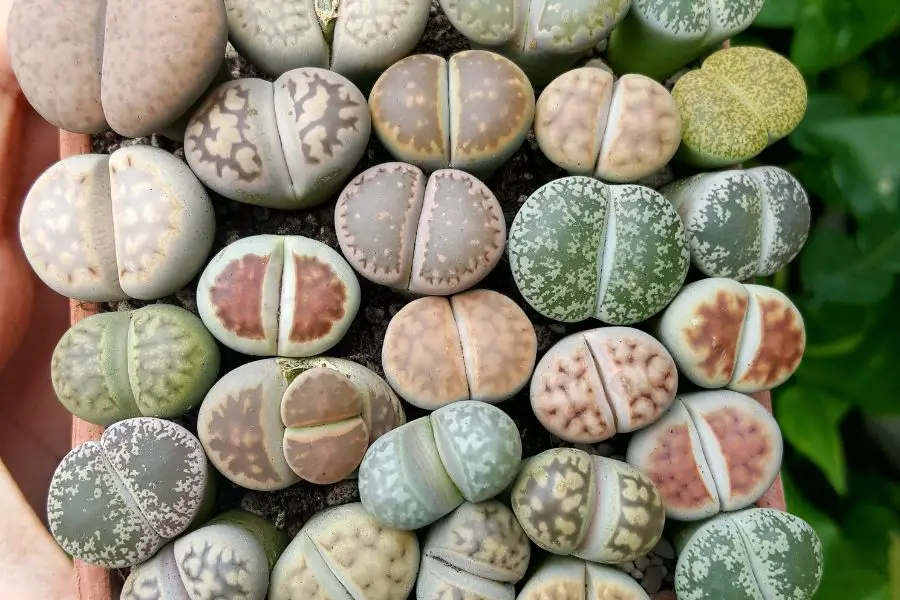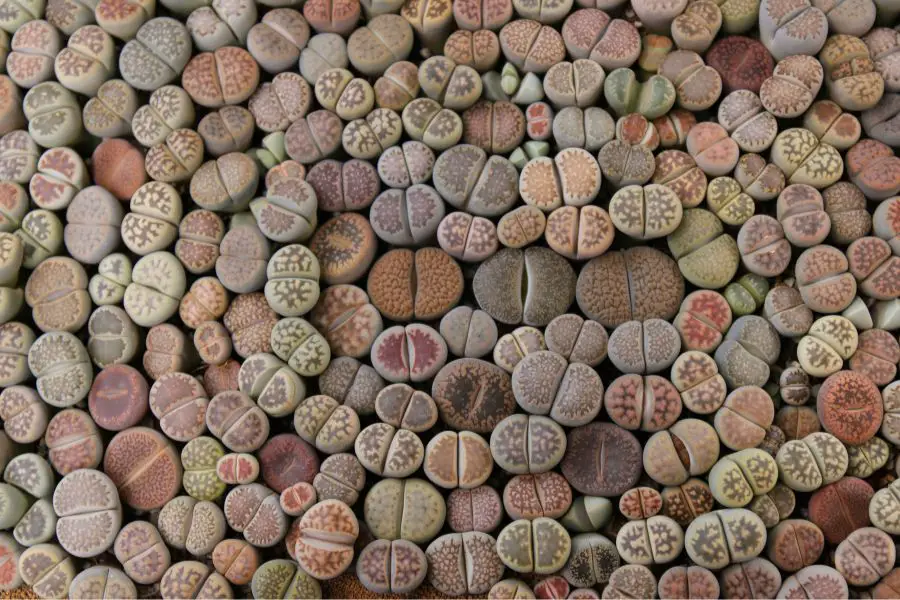With their bizarre pebble-like appearance and exacting care needs, lithops may seem like difficult plants suited only for experts. But don’t let their peculiar looks deceive you!

When provided with the right conditions, these novelty succulents can actually make fantastic starter plants. Here’s an in-depth look at the unique charms and particular requirements of lithops for beginners.
An Introduction to Lithops
Lithops, also aptly known as “living stones”, are a species of small succulents native to southern Africa. They belong to the larger Aizoaceae family, which includes other stone-resembling succulents like baby toes and split rocks. There are over 40 different species of lithops, but they all share some common traits:
- Pebble or clam-shaped leaves that mimic stones
- Pairs of leaves joined at the base
- Leaves split open with flowers inside
- Varied leaf coloration and patterns
- Very slow growing
- Grow in rocky areas prone to drought
These highly specialized succulents have evolved to expertly blend in with the stones and pebbles in their native habitat. Their shape and coloration helps provide camouflage to survive. The windowed tips of the leaves allow light in for photosynthesis. Their appearance is certainly bizarre and alien-like!
But don’t judge a book by its cover – lithops might seem like oddball plants best left to experts, but read on to understand why beginners shouldn’t fear these funky succulents.
What Makes Lithops a Good Beginner Succulent?
Lithops have some key qualities that actually lend themselves well to cultivation by novice succulent growers:
They Stay Extremely Small
Lithops grow very compact, reaching only about 2-3 inches wide at maturity. Their tiny size makes them perfect for windowsills, desktops, and small containers. You don’t need a lot of space to grow them.
Low Growth Rate
Lithops are incredibly slow growing – it can take 5+ years for them to reach full size. This is a plus for beginners who want to enjoy their plants for a long time without constantly repotting and dividing them.
Give Visual Interest
The charming and unusual stone-like appearance of lithops provides visual intrigue. Their colors and patterns give you lots of diversity to admire. Great for anyone who wants uniquely beautiful plants.
Tolerate Some Neglect
Once properly planted, lithops are tolerant of occasional neglect in terms of watering. As long as you don’t overwater and provide good light, they won’t just suddenly die. Their resilience makes them more beginner friendly.
Low Cost
You can purchase nice starter lithops for just a few dollars. They are affordable plants to try out and gain experience growing succulents, without a big investment.
Easy Propagation
Lithops readily produce offsets, allowing you to easily increase your collection. Propagating gives beginners valuable practice with reproduction.
So lithops can actually make ideal “gateway succulents” to start out with due to their petite size, slow growth, visual appeal, resilience and low cost – as long as you follow a few important care guidelines.
Growing Conditions Lithops Need
While lithops are suitable starter succulents in many ways, they do have some specific care needs:
Sunlight
Bright light is a must! Lithops require very intense light, equivalent to full blazing outdoor sun. South-facing windows can provide sufficient sunlight indoors – just watch for any stretching toward the light. Always opt for the sunniest spot available.
Soil
Very fast draining soil is critical to prevent rot. A mix made with equal parts potting soil, coarse sand, and perlite will provide proper drainage. Never allow lithops to sit in wet soil for prolonged periods.
Watering Regimen
This is the trickiest part of growing lithops successfully. In autumn and winter, lithops go dormant and should receive zero water at all. Only resume light watering when the old leaves have completely shriveled. The growing season in spring and summer requires precise minimal watering. Take care not to ever overwater, but don’t underwater either. Pay close attention to leaf wrinkling.
Temperature & Humidity
Lithops prefer daytime temperatures around 70-80°F (20-26°C) and cooler nights around 50-60°F (10-15°C). Low humidity below 50% is recommended. They can be prone to fungal issues with excess moisture in air.
Pot Size
Pick shallow pots, not much larger than the clump of plants. Deep pots retain too much moisture around the roots. Terra cotta and other porous containers are ideal for improved evaporation.
Common Problems for Lithops
When provided with suitable conditions, lithops are fairly hardy succulents. But beginners should watch for these potential problems:
- Overwatering – Causes rot, the #1 killer of lithops. Water minimally.
- Underwatering – Leaves shrivel severely. Resume light watering.
- Poor drainage – Wet soil leads to decay and death. Use very gritty soil.
- Low light – Insufficient sun makes leaves elongate and split poorly. Give maximum light.
- Fungal diseases – High humidity and moisture invite fungal issues. Improve airflow and reduce water.
- Pests – Mealybugs can infest lithops. Treat with pesticides or alcohol.
With the right adjustments and vigilance, these problems can be avoided and lithops can thrive for beginners. Pay close attention to your plant’s needs.

Tips for Growing Lithops
Here are some top tips for successfully cultivating lithops as beginner plants:
- Acclimate new lithops slowly to avoid sunshock in brighter indoor conditions.
- Pot in very shallow containers – depth of 3 inches maximum.
- Top dress with pebbles or gravel to protect the soil from intense light exposure.
- Fertilize lightly only during the spring and summer growing season.
- Allow the old outer leaves to fully shrivel before watering to prevent rot.
- Never water during the autumn and winter dormancy period.
- Space plants 2-3 inches apart to allow maximum sun and air circulation.
The Takeaway
While lithops have some particular needs, their compact size, slow growth, drought tolerance, and propagation ability makes these eccentric succulents suitable and rewarding for beginners who provide the required bright light and minimal water. J
ust be sure to do your research on their care before buying lithops. Their distinctive living stone appearance and neat habits will delight novice succulent collectors.
With some attention to their growing preferences, you can keep your lithops thriving for years to come. Give lithops a try and see just how fun these funky succulents can be!
Read Next:
Lithops Karasmontana Red Top (Stone Like Plant)| 13 Care Facts |
Lithops Karasmontana | 14 Most Effective Ways To Care |
